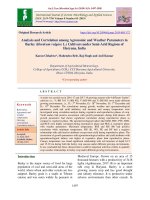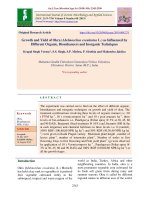Productivity and profitability of rain fed barley (Hordeum vulgare) crop as influenced by variety, fertility and moisture conservation
Bạn đang xem bản rút gọn của tài liệu. Xem và tải ngay bản đầy đủ của tài liệu tại đây (215.52 KB, 6 trang )
������������������������������������������������������������������������������������������������������������������������������������������������������������������������������������������������������������������������������������������������������������������������������������������������������������������������������������������������������������������������������������������������������������������������������������������������������������������������������������������������������������������������������������������������������������������������������������������������������������������������������������������������������������������������������������������������������������������������������������������������������������������������������������������������������������������������������������������������������������������������������������������������������������������������������������������������������������������������������������������������������������������������������������������������������������������������������������������������������������������������������������������������������������������������������������������������������������������������������������������������������������������������������������������������������������������������������������������������������������������������������������������������������������������������������������������������������������������������������������������������������������������������������������������������������������������������������������������������������������������������������������������������������������������������������������������������������������������������������������������������������������������������������������������������������������������������������������������������������������������������������������������������������������������������������������������������������������������������������������������������������������������������������������������������������������������������������������������������������������������������������������������������������������������������������������������������������������������������������������������������������������������������������������������������������������������������������������������������������������������������������������������������������������������������������������������������������������������������������������������������������������������������������������������������������������������������������������������������������������������������������������������������������������������������������������������������������������������������������������������������������������������������������������������������������������������������������������������������������������������������������������������������������������������������������������������������������������������������������������������������������������������������������������������������������������������������������������������������������������������������������������������������������������������������������������������������������������������������������������������������������������������������������������������������������������������������������������������������������������������������������������������������������������������������������������������������������������������������������������������������������������������������������������������������������������������������������������������������������������������������������������������������������������������������������������������������������������������������������������������������������������������������������������������������������������������������������������������������������������������������������������������������������������������������������������������������������������������������������������������������������������������������������������������������������������������������������������������������������������������������������������������������������������������������������������������������������������������������������������������������������������������������������������������������������������������������������������������������������������������������������������������������������������������������������������������������������������������������������������������������������������������������������������������������������������������������������������������������������������������������������������������������������������������������������������������������������������������������������������������������������������������������������������������������������������������������������������������������������������������������������������������������������������������������������������������������������������������������������������������������������������������������������������������������������������������������������������������������������������������������������������������������������������������������������������������������������������������������������������������������������������������������������������������������������������������������������������������������������������������������������������������������������������������������������������������������������������������������������������������������������������������������������������������������������������������������������������������������������������������������������������������������������������������������������������������������������������������������������������������������������������������������������������������������������������������������������������������������������������������������������������������������������������������������������������������������������������������������������������������������������������������������������������������������������������������������������������������������������������������������������������������������������������������������������������������������������������������������������������������������������������������������������������������������������������������������������������������������������������������������������������������������������������������������������������������������������������������������������������������������������������������������������������������������������������������������������������������������������������������������������������������������������������������������������������������������������������������������������������������������������������������������������������������������������������������������������������������������������������������������������������������������������������������������������������������������������������������������������������������������������������������������������������������������������������������������������������������������������������������������������������������������������������������������������������������������������������������������������������������������������������������������������������������������������������������������������������������������������������������������������������������������������������������������������������������������������������������������������������������������������������������������������������������������������������������������������������������������������������������������������������������������������������������������������������������������������������������������������������������������������������������������������������������������������������������������������������������������������������������������������������������������������������������������������������������������������������������������������������������������������������������������������������������������������������������������������������������������������������������������������������������������������������������������������������������������������������������������������������������������������������������������������������������������������������������������������������������������������������������������������������������������������������������������������������������������������������������������������������������������������������������������������������������������������������������������������������������������������������������������������������������������������������������������������������������������������������������������������������������������������������������������������������������������������������������������������������������������������������������������������������������������������������������������������������������������������������������������������������������������������������������������������������������������������������������������������������������������������������������������������������������������������������������������������������������������������������������������������������������������������������������������������������������������������������������������������������������������������������������������������������������������������������������������������������������������������������������������������������������������������������������������������������������������������������������������������������������������������������������������������������������������������������������������������������������������������������������������������������������������������������������������������������������������������������������������������������������������������������������������������������������������������������������������������������������������������������������������������������������������������������������������������������������������������������������������������������������������������������������������������������������������������������������������������������������������������������������������������������������������������������������������������������������������������������������������������������������������������������������������������������������������������������������������������������������������������������������������������������������������������������������������������������������������������������������������������������������������������������������������������������������������������������������������������������������������������������������������������������������������������������������������������������������������������������������������������������������������������������������������������������������������������������������������������������������������������������������������������������������������������������������������������������������������������������������������������������������������������������������������������������������������������������������������������������������������������������������������������������������������������������������������������������������������������������������������������������������������������������������������������������������������������������������������������������������������������������������������������������������������������������������������������������������������������������������������������������������������������������������������������������������������������������������������������������������������������������������������������������������������������������������������������������������������������������������������������������������������������������������������������������������������������������������������������������������������������������������������������������������������������������������������������������������������������������������������������������������������������������������������������������������������������������������������������������������������������������������������������������������������������������������������������������������������������������������������������������������������������������������������������������������������������������������������������������������������������������������������������������������������������������������������������������������������������������������������������������������������������������������������������������������������������������������������������������������������������������������������������������������������������������������������������������������������/m2
2011-12
88.9
Dry wt. of
roots/plant
(g)
2012-13
2011-12
2011-12
2012-13
2012-13
2011-12
Varieties
Haritma
Root depth
(cm)
2.410
43.5
8
44.3
2
45.7
0
0.61
34.2
1
32.6
2
32.4
3
0.28
32.50
0.032
44.2
3
45.1
6
46.1
9
0.15
0.080
0.33
1.35
0.62
0.70
2.02
5
2.12
5
2.28
0
0.02
6
0.05
3
2.230
43.4
8
44.7
0
45.4
2
0.64
32.5
3
33.2
3
35.5
0
0.38
31.82
0.030
44.2
6
45.2
6
46.0
6
0.19
0.061
0.40
1.31
0.79
0.51
2.09
9
2.14
8
0.01
5
0.03
3
2.300
44.4
3
44.6
4
0.50
32.7
2
33.5
2
0.23
32.30
0.026
45.1
0
45.3
8
0.12
0.057
NS
NS
0.51
0.57
2.283
2.348
2.383
2.428
2.394
33.74
33.31
0.31
33.08
34.65
0.25
34.06
0.26
Int.J.Curr.Microbiol.App.Sci (2017) 6(6): 2952-2957
Table.2 Effect of varieties, fertility levels and moisture conservation practices on yield, water use and economics of barley
Treatments
Grain yield (q/ha)
Stover yield
(q/ha)
Total water use
(mm)
Water use
efficiency kg
grain/ha mm
Net return
Benefit: cost ratio
2011-12
2012-13
201112
201213
201112
201213
2011-12
2012-13
201112
201213
2011-12
2012-13
Haritma
27.49
27.62
55.00
57.17
179.5
171.0
15.3
16.2
22546
23147
1.95
1.98
Narmada
27.38
28.65
54.30
55.79
179.2
171.4
15.3
16.7
22265
24189
1.94
2.02
Lakhan
24.39
25.88
50.81
51.55
178.8
169.2
13.6
15.3
17740
19795
1.75
1.84
S.Ed. ±
0.70
0.53
0.78
0.90
0.8
0.7
0.2
0.2
-
-
-
-
C.D. (P=0.05)
1.31
1.19
1.73
2.01
NS
1.5
0.4
0.4
-
-
-
-
N40 P20 K20
22.78
21.56
47.11
46.20
177.2
150.0
12.8
14.4
16033
14290
1.71
1.63
N60 P30 K30
27.26
29.03
54.60
58.65
179.9
180.4
15.1
16.1
22172
25247
1.94
2.07
N80 P40 K40
29.22
31.57
57.81
59.66
180.6
181.2
16.2
17.4
24230
27608
1.98
2.12
S.Ed. ±
0.81
0.48
1.24
0.83
0.9
0.7
0.3
0.2
-
-
-
-
C.D. (P=0.05)
1.64
0.99
2.57
1.70
2.1
1.5
0.6
0.4
-
-
-
-
Hand Weeding
26.01
25.73
53.37
53.64
179.1
170.3
14.5
15.1
19528
19223
1.80
1.79
Pendimethaline
26.83
29.04
53.40
56.03
179.3
170.8
15.0
17.0
22179
25534
1.97
2.12
S.Ed. ±
0.57
0.44
0.64
0.74
0.5
0.5
0.2
0.1
-
-
-
-
C.D. (P=0.05)
NS
0.97
NS
1.64
NS
NS
NS
0.3
-
-
-
-
Varieties
Fertility levels
Moisture
conservation
2956
Int.J.Curr.Microbiol.App.Sci (2017) 6(6): 2952-2957
Economics
The varieties ‘Haritma’ and ‘Narmada’ being
almost at par recorded considerably higher
values of net return and B: C ratio during both
years. On mean basis of two years data,
‘Narmada’ and ‘Haritma’ earned Rs. 4459.5
and 4079.0/ha or 23.8 and 21.7% more net
return, respectively than the variety ‘Lakhan’.
It might be attributed to grain and straw yield
because cost of cultivation was same for all
varieties. Net return also increased with
increasing fertility up to N80 P40 K40 level
which earned Rs. 10757.5 and 2209.5/ha
more or 71.0 and 9.3% higher over N40 P20
K20 and N60 P30 K30 levels, respectively on
mean basis of 2-year data B: C ratio followed
the same trend of net return. Higher net
returns might be attributed to higher grain and
straw yields. The margin of yield increase
was much higher than cost involved in
additional fertilizer, thus net return and B: C
ratio both improved with fertility. These
results are in corroboration with the findings
of Meena et al., (2012). Among moisture
conservation practices, pre-E spray than hand
weeding. On mean basis of 2-year data,
pendimethaline spray earned Rs. 4481/ha or
23.1% higher net return than hand weeding. It
might be attributed to lower cost involved in
pendimethaline spray and higher crop yield.
These results may be concluded that for
rainfed condition of central Uttar Pradesh,
barley varieties ‘Narmada’ and ‘Haritma’
along with 80 kg N+40 kg P2O5 + 40 kg
K2O/ha and pre-emergence spray of
pendimethaline @ 3.3 litres/ha are equally
effective for higher productivity and
profitability.
References
Awasthi, U.D, Bhan, S. and Uttam, S.K.
(1993). Root development and moisture
use in wheat (Triticum aestivum) and
Barley (Hordeum vulgare) as influenced
by crop variety and nitrogen. Indian
Journal of Agronomy, 38 (4): 559-561.
Meena, L.R. Mann, J.S. and Meena, S.L.
(2012). Effect of levels and mode of
nitrogen application on dual purpose
barley (Hordeum vulgare) under semiarid condition. Indian Journal of
Agronomy, 57 (2): 168-170.
Palaniappan, S.P. and Sivaraman, K. (1996).
Cropping systems in the tropics:
Principles and management, pp. 28-35,
New Age International Publishers, New
Delhi-110002.
Puniya, M.M., Yadav, S.S. and Shivram, A.C.
(2015). Productivity, profitability and
nitrogen use efficiency of barley
(Hordaem vulgare) as influenced by
weed management and nitrogen
fertilization under hot semi-arid
ecologies of Rajasthan. Indian Journal
of Agronomy, 60 (4): 564-569.
Saini, J.P. and Thakur, S.R. (1999). Response
of barley (Hordeum vulgare) varieties
to nitrogen under dry temperate
conditions.
Indian
Journal
of
Agronomy, 44 (1): 123-125.
How to cite this article:
Awasthi, U.D., Shailendra Pratap Singh, P.K. Mishra, Brajesh Prajapati and Abhishek Singh.
2017. Productivity and Profitability of Rain Fed Barley (Hordeum vulgare) Crop as Influenced
by Variety, Fertility and Moisture Conservation. Int.J.Curr.Microbiol.App.Sci. 6(6): 29522957.
doi: />
2957
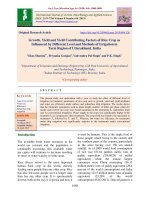

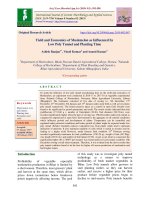
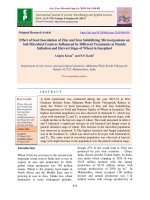
![Growth and yield of Ashwagandha [Withania somnifera (L.)] as influenced by different intercropping system in Kymore plateau of Madhya Pradesh](https://media.store123doc.com/images/document/2020_01/09/medium_vsb1578562778.jpg)

